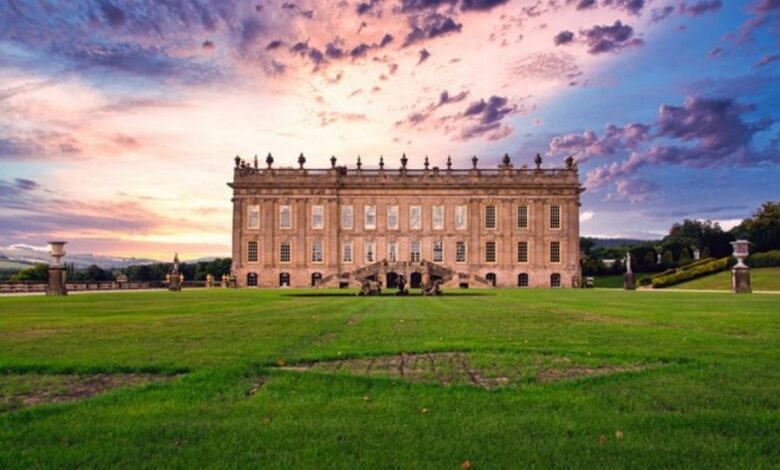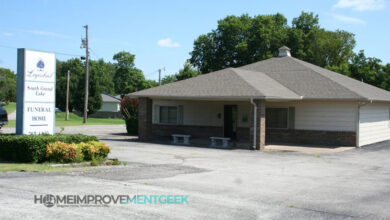The Majestic Beauty of Chatsworth House

Nestled in the idyllic Derbyshire Dales lies one of England’s most breathtaking historic houses. Chatsworth House has captured the imagination for centuries with its magnificent architecture, world-renowned art collection, sprawling gardens, and the captivating story of the Cavendish family who have called it home since 1549.
A Storied History of Chatsworth House
Chatsworth House enjoys a long and illustrious history stretching back over 450 years. Its storied past is intricately interwoven with the lives of remarkable individuals who left an indelible mark not only on the estate itself but on English society.
The Birth of an Icon
Construction first began on the Chatsworth House site in 1555 under the watchful eye of the formidable Bess of Hardwick. Along with husband Sir William Cavendish, they built a Tudor mansion in the 1560s which formed the foundation upon which future generations would continue to develop the estate.
Even in its infancy, Chatsworth House was destined for greatness as Bess set about creating a fitting home for the dynasty she was determined to establish.
The Cavendish Legacy
The Cavendish family has maintained a tight grasp on Chatsworth House since Bess of Hardwick passed the estate to her second son, William Cavendish, 1st Earl of Devonshire in 1601. Over the centuries, succeeding heirs have made their improvements while preserving the integrity of what came before them.
Periodic upgrades were necessary to mold an aging Tudor mansion into a residence befitting the eminent status of the Cavendish line.£32.7 million was invested between 2005 to 2018 alone to sensitively restore areas at risk while enhancing visitor facilities. This balance between past and present has enabled Chatsworth House to evolve with the times yet retain its original identity.
The unwavering commitment of the Cavendish family has ensured the grandeur and artistic treasures amassed over 16 generations have been conserved for posterity. Their devotion speaks not just to their noble pedigree but also to a sense of duty to preserve the home and rich cultural heritage gifted to them.
Magnificent Architecture
Chatsworth House is a breathtaking expression of architectural genius featuring the convergence of English Baroque and Italianate styles. This striking country house radiates nobility from every precisely cut stone thanks to a parade of venerable names who assisted the Cavendish lineage in actualizing their grand vision.
Exterior Majesty
The exterior elevations of Chatsworth House are resplendent in the afternoon Derbyshire sun. Golden hues dance across symmetrical rows of stately windows framed by eloquently carved rusticated stone. The light splays across proud parapets crowning both front and rear facades, each towering chimney and cupola infused with texture and shadow.
Sweeping lawns extend outwards, drawing visitors towards regally-formed steps kissed by water jets in the twin fountains. Majestic gatehouses stand like sentinels heralding passage across the great bridge over the River Derwent towards the main entrance. Each element combines harmoniously into a captivating display of nobility and status masterfully communicated through classical architecture.
An Impressive Lineage
The south front with its breathtaking painted hall and procession of state rooms was the work of eminent architects Sir William Talman and Thomas Archer. Their original 1688 design was extended outwards in the 19th century by Jeffry Wyatville who introduced the impressive North Wing.
Later contributions came from Joseph Paxton, renowned for his spectacular Crystal Palace, who innovated functional yet decorative additions like the Great Conservatory during his time as head gardener in the 1830s. James Paine too left his mark—his elegant stables and bridge both scaled appropriately to avoid detracting from the grandeur of the house itself.
Each architect succeeded in seamlessly integrating their enhancements while retaining harmony with what came before. This demonstrates remarkable reverence for the past and astounding talent to build upon the established aesthetic.
Opulent Interiors
If visitors are left awestruck by Chatsworth House’s palatial exterior, they will be mesmerized when exploring inside. Sumptuously decorated rooms spanning three floors overflow with treasures amassed across half a millennium. The sheer scale and attention to detail surpass even the most lavish of palaces.
No surface is left unadorned, and no opportunity for embellishment is overlooked. No expense was spared in applying gilt, carvings, paint, and textiles to delight the senses and reinforce the supremacy of the noble family dwelling within.
Rooms Worthy of Royalty
From entering the light-infused Painted Hall with its spectacular ceiling depicting Julius Caesar’s triumph to climbing the grand oak staircase past centuries of Devonshire ancestors captured in oils, visitors encounter majesty in every direction.
The State Apartments thrill with rooms decked out as though expecting royal guests at any moment. The crimson State Dining Room positively gleams under the flicker of a Waterford crystal chandelier while priceless art salutes guests from every wall of the State Drawing Room.
The West Wing draws the eye upwards through the cast iron Belvedere Tower to an open roof terrace crowning the North Wing. Light floods in from a glass dome ceiling washing over balconies lining three stories of arched bookshelves.
These emphasize not just worldly influence but the value placed on erudition. Indeed, the library and sculpture gallery speak to the broad intellectual curiosity of successive generations rather than just showcasing immense fortune.
Lavish staterooms sit side-by-side with more intimate family quarters and guest apartments. Despite imposing dimensions, decorative details create comfortable reprieves promoting warm conversation; a testament to the genteel nature of the family occupying its hallowed halls.
Artistic Riches
While renowned for sumptuous architecture and decadent trappings of aristocracy, Chatsworth House holds an even greater treasure—an internationally-revered art collection spanning over 4000 years of creative endeavor. Masterworks beloved the world over coexist harmoniously with avant-garde offerings from contemporary greats.
The Devonshire Collections
Initiated by 4th Duke William Cavendish and his wife Charlotte who inherited outstanding pieces from her father, Lord Burlington, the Chatsworth House art trove expanded significantly through inheritance and keen connoisseurship. Their descendants shared a passion that today sees riveting Roman statuary, Renaissance tapestries, and illuminated manuscripts displayed alongside Cecil Beaton photography, Lucien Freud sketches, and Dame Elisabeth Frink sculptures.
Spread throughout the house, galleries enable visitors to come face-to-face with seminal works by artists including Rembrandt, Impressionist painters, Old Masters like Titian, Tintoretto, and Veronese, and 20th-century luminaries like Walter Sickert. Each room unravels fresh stories through diverse artistic voices documented on canvas, in marble, bronzes, and precious metals.
Celebrated Masterstrokes
Particular highlights for art enthusiasts include four Rembrandt paintings with arresting self-portraits and biblical scenes as well as his evocative late sketch Two Old Men Disputing. Veronese’s vibrant Venus and Adonis captivates alongside cherished family portraits by Reynolds, Romney, and Gainsborough.
But Chatsworth also holds fathoms of art history that people may be less acquainted with. Exquisite 15th-century Flemish altar pieces, Islamic pages mixing calligraphy, geometric shapes, and nature, French Impressionism, and British sculpture like Alfred Gilbert’s Icarus—all pepper rooms in curious dialogue.
These thrilling artistic accounts remind us of our shared human experience across millennia yet also reveal the unique preoccupations of different ages. William Cavendish and his descendants prove astute curators, placing prized acquisitions in carefully selected settings allowing art to enlighten through beauty, emotion, and metaphor.
Contemporary Exhibitions
The current custodians of Chatsworth House build upon the legacy of their forebears by integrating boundary-pushing contemporary art into the 500-year narrative. The celebrated Beyond Limits outdoor sculpture exhibitions have showcased artists like Lynn Chadwick, David Nash, and Sophie Ryder.
Inside, the newly extended East Wing will host a range of modern art displays cementing Chatsworth’s reputation as an enduring cultural hub. The 2023 Mirror Mirror exhibition promises magical reflections between avant-garde creations by Fred Baier, Paul Cocksedge, and Alicja Kwade with the timeless surroundings of this remarkable house.
Once again, the Cavendish bloodline proves remarkably progressive, recognizing the fluid, shape-shifting wonder of art across the ages. Their collective curation allows Old Masters and experimental pioneers to speak as one, delighting us with jewels of cultural enlightenment.
Breathtaking Gardens & Grounds
Beyond architectural magnificence and artistic gems, Chatsworth House is encircled by some of England’s most beautiful gardens and parklands. Sweeping vistas over fountains towards wooded hillsides make it a dramaturgical masterpiece as alive with color and texture as any canvas inside.
Sculpted Beauty
While Capability Brown harmoniously integrated the 105-acre grounds into the Derbyshire hills from the 1760s, they remain meticulously manicured. The artistry of water set against vibrant blooms, softer sensory plantings, and neoclassical statues create an idyllic, Arcadian aura.
Visitors amble downhill from the house through an enchanting patchwork of garden rooms. The Baroque grandeur of the South Cascade with its 24 steps has delighted for over 300 years. The bubbling Emperor Fountain still astonishingly reaches great heights through water power alone.
Those preferring more relaxed reflective spaces may linger in the scented rose garden watching bees dart between flowers. The Arboretum walk features soaring Giant Sequoias alongside elegant Chinese Maidenhair trees gathered from across the globe—all coexisting peacefully through careful horticultural design.
And fun reigns freely in the Adventure Playground with tension-banishing thrills of zip wires, tree climbing and splash pools to spark childish laughter. Chatsworth shares its appeal across generations.
Changes Over Time
While original 1695 features like the Cascade and Canal Pond remain treasured attractions, the gardens also bear witness to changing fashions and innovation. The 11th Duke and Duchess supervised an injection of new energy from the 1950s. Vibrant colors and patterns introduced with the South Lawn limes and the lively bombing of the Serpentine Hedge signaled an increasingly contemporary ambiance.
Openness to trailblazing design accounts for contemporary additions like the Galvanized Garden’s metallic sculpture and Edwin Hamilton’s The Painted Pebbles, giant color-saturated stones creating a puzzling illusion. Yet a respectful consistency of materials, positioning, and purpose means modern elements feel remarkably fitting. The garden has evolved as seamlessly as the house interior.
A Vast Verdant Playground
Beyond smartly attired garden parterres, Chatsworth spills into the Derbyshire countryside offering rambling wild freedom. The open park sweeps downhill via riverside trails and dense woods towards farms with livestock nosing through grassy fields.
Leafy hideouts and rocky lookouts prove irresistible for families relishing the outdoors. This rich topography offers habitat for all manner of creatures including herds of deer as well as birdlife. Nature flourishes through both hearty resilience and a nurturing coexistence with people.
These thousand acres feel simultaneously wild and meticulously cared for just like Chatsworth House itself. The Cavendish family aims not to tame but to amplify the beauty and liveliness already abundant in the Peak District. Their contribution is considered and creative—framing views, guiding footsteps towards beguiling spaces for memorable interactions between humanity and the natural world.
Planning Your Visit
Marveling at this wonderland for art, history, and nature enthusiasts need not be a distant daydream. Chatsworth House and Gardens is open from March through December with tickets, tours, and ample facilities catering to all interests and ages.
Practical Tips
Chatsworth House lies around three miles from Bakewell, reached via the B6012 through Rowsley. Car parking is readily available and public buses stop nearby. Rail connections via Chesterfield or Matlock link to buses onwards to the house.
It is recommended to arrive early during peak periods to beat queues for house entry. Tickets allow self-guided exploration with volunteers stationed in rooms to illuminate highlights and anecdotes. Family multimedia guides, large print scripts, and mobility assistance ensure full accessibility.
The Farmyard, Adventure Playground, Garden, Park, cafes, and restaurants stay open longer for those wishing to linger. Picnics are encouraged outside and many items are available to purchase from the well-stocked Farm Shop.
With so much on offer, it is advisable to review the website when planning itineraries tailored to time available, mobility, and particular areas of interest. Special events like outdoor theatre, Christmas markets, and horse trials are also worth noting.
Contemporary Hospitality
While the rich heritage is undisputedly the principal draw for visitors, Chatsworth House recognizes modern audiences appreciate contemporary comforts. As such, hospitality has expanded greatly in recent years while retaining an intimate connection to history.
The house offers light catering in the charming 18th-century Hunting Tower as well as elegant fine dining in the lavish Georgian Chatsworth restaurants. Artisan treats at the Carriage House Café or Cavendish Coffee House complement tastings of estate produce like venison, charcuterie, craft ales, and award-winning wines and spirits.
Those preferring to self-cater have an abundance of locally sourced deli delights, fruits and vegetables, cheeses, cured meats, and freshly baked goods at their disposal in the bustling Farm Shop.
Overnight visitors may select from a broad portfolio of hotel and self-catering accommodation options on site from cozy cottages to five-star suites—some even occupying corner towers of the house itself for complete fairytale immersion.
Wherever one wanders at Chatsworth, contemporary hospitality seamlessly fuses with historic architecture and atmosphere. The dukes and duchesses through the centuries surely approve of standards befitting their legacy being upheld.
An Enduring Legacy
While many English country estates struggled in the 20th century, Chatsworth House has been reinvigorated. Alongside investing millions in restoration and development, the Cavendish family demonstrates remarkable business acumen, securing Chatsworth’s future for generations to come.
Expanding Commercial Enterprises
In 1981 trustees ensured the long-term preservation of the house, art, and grounds by establishing the Chatsworth House Trust. This oversees management, conservation funding, and community outreach.
The family parallels this organization’s efforts by spearheading an array of commercial initiatives sharing the unique Chatsworth experience far beyond its historic walls. Alongside signature restaurants and cafes, branded fine foods, homewares, and fashion grow the brand.
A dozen retail outlets and holiday accommodations cater to visitor demand, not to mention festivals, open-air cinema, and celebrations. Rural management supports agricultural tenancies and nurtures hardship enterprises and local suppliers.
Maximizing income enables ongoing investments into a sustainable future. Reinvesting in assets reveals savvy business instincts belying the risk of aristocratic caricatures.
Leadership Carrying a Legacy
The growing commercial empire sits comfortably with 12th Duke Peregrine Cavendish and Duchess Amanda Harlech Cavendish who still consider the estate a family seat.
The intimate family apartments shielded from the public wing reveal that alongside augmenting an inheritance, they see themselves as guardians entrusted with expanding enriching emotional and societal value.
Through artistic patronage invigorating regional creativity and upholding cherished traditions like the annual teen village dance, they tangibly shape regional culture beyond economic inputs. Their leadership marries past and future as astutely as the architecture brings eras into inspiring dialogue.
Investing in Posterity
Passionate advocacy permeates all aspects of the current custodians’ roles. From championing sustainable power solutions to superseding accessibility improvements and nurturing free expression through creative arts, they lead beyond wealth. Moral consciousness self-evidently guides financial investments and business diversification supporting the entire community.
With astute curation amplified by amplifying access through contemporary hospitality and dynamic experiences, their positive impact will flow through England’s heritage landscape for decades.
The Enduring Allure of Chatsworth House
Chatsworth House stands proudly as one of England’s most breathtaking treasure houses. Architectural finery, bounties of art, and acres of beauty come together to create visual pleasure and compelling escapism. But the roots embedding this phenomenal estate in the Derbyshire earth prove equally compelling.
The Cavendish family history reveals tenacity, sparkling personalities, intrigues, and cultural influence as richly vibrant as painted ceilings and gilded furniture within. Their abode breathes life through layers of artifacts and memories across five centuries of resolve to craft an ode to nobility and erudition.
This magnificent house remains an enthralling jewel demanding visitation. Like the family who call it home, Chatsworth welcomes onlookers not with aloofness but warmth and generous revelation of hard-won wisdom. Its rooms foster as much inspiration and imaginative transport today as since Bess of Hardwick cut the first sod over 450 years past.
An Iconic Legacy
As we leave Chatsworth’s magnificent halls, the imprint left by 16 generations of Cavendish creators and curators remains awe-inspiring. Their shared passion for arts and nurturing beauty produced one of history’s most expansive cultural collections.
Chatsworth House stands as a testament to the fruits of creative collaboration spanning five centuries. The initial vision of Bess of Hardwick has been honored through devotion to developing rather than diminishing the singular character that emerged from her remarkable intellect.
Custodians through changing tides of societal progress never rested on privilege, nor isolated their riches. Guided by an inherent spirit of generosity, they unlocked doors to hidden gems that all might delight together. From Old Masterpaintings to avant-garde installations, wonder permeates these spaces welcoming inquisitive minds.
A Revitalizing Legacy
Beyond visual treasures, the Cavendish hospitality legacy enriches all drawn into its orbit. The family’s focus extends beyond preserving heritage to actively empathizing with how their treasures might sustain and inspire diverse communities.
Innovative commercial strategies amplify access further still without compromising the core cultural mission. Chatsworth nourishes creativity, personal journeys, and a shared inheritance rising above social divides. It connects and revitalizes at the deepest human level.
Contemporary patrons can learn much from this ethos embracing reinvention without sacrificing the foundations and spirit of the past. For it is the emotional rescue of those who grafted before that propels the estate decisively towards its next vibrant era.
The Cavendish family and Chatsworth House gift all a moving masterclass in guardianship—how vision coupled with care for people not just objects lays foundations, brick-by-brick inspiring essential societal progress century after century. Their home will forever stir imagination and empathy through the profound legacy of 16 remarkable lives lived in creative service to all who follow.




